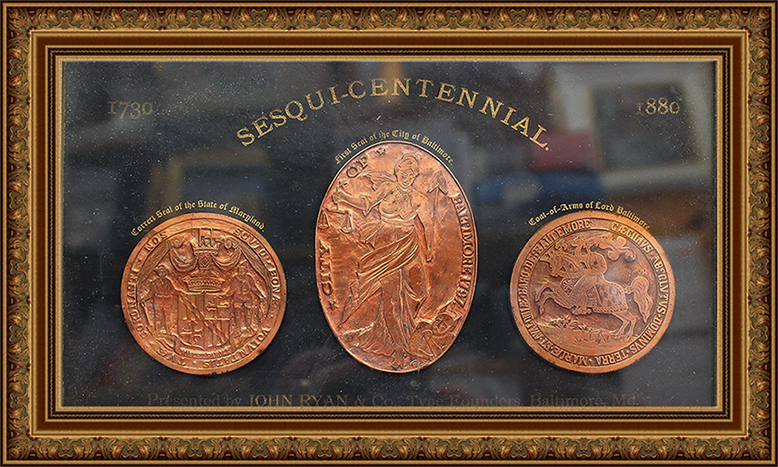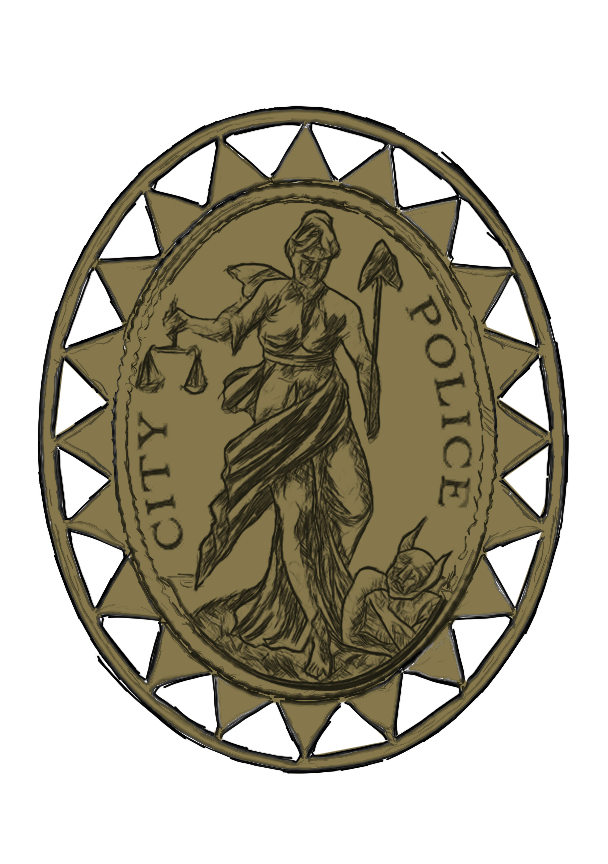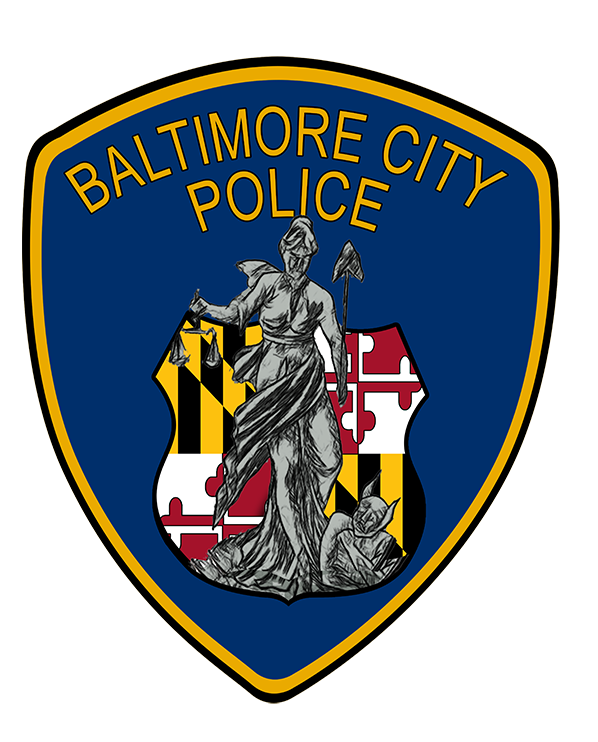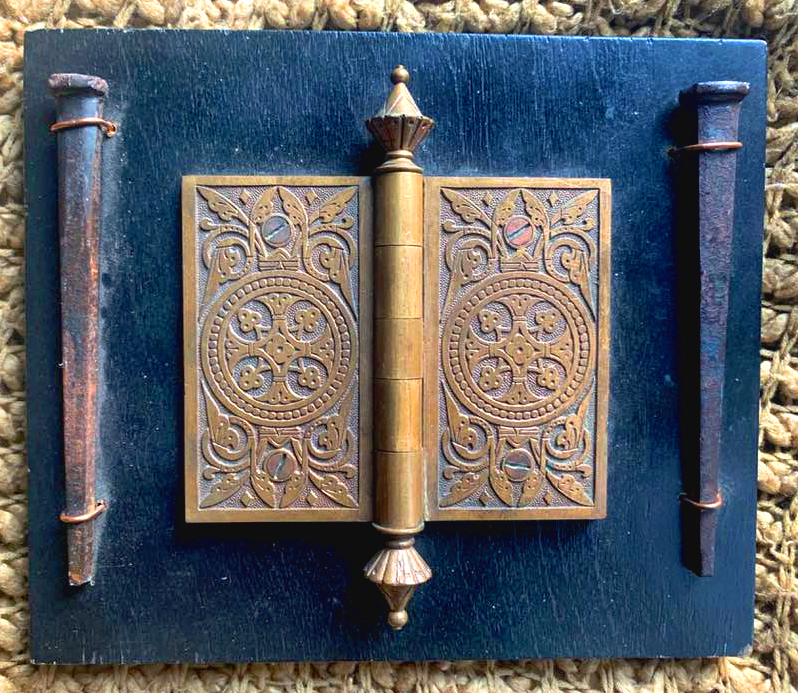1st Seal
The 1st Seal of Baltimore
![]()

This seal is the Center Seal from a set of three Electrotypes
It was called The Sesqui-Centennial of Baltimore of 1880
and features what was known as the
Grand Old Seal of the City of Baltimore, designed in 1797
The Maryland Seal and the Baltimore Arms
1 Nov 1880
For The Sun COSMOS
The Sun (1837-1987); Nov 1, 1880; pg. 6
The Maryland Seal and the Baltimore Arms
In the Library of the City Hall you will find two electrotypes, one of which is called “The Seal of the State of Maryland” the other “The Coat of Arms of Lord Baltimore” and the maker of these electrotypes was mistaken in respect to both of them, for the one is not “The Seal of Maryland” nor is the other “Lord Baltimore Coat of Arms” the first is a copy of one side of the “Eventual Seal Of Maryland” not the seal of the state. And the other is a copy of the counter side of the same seal, with but little on it relating to Lord Baltimore’s Coat of Arms. (1) These misnamed electrotypes are placed at the right and left of another which represents that the Grand Old Seal of the City of Baltimore, made in 1797, and they should be taken away, for they stand out in the picture as falsehood in support of the truth. (2) History is too frequently falsified in marble and in bronze; monuments pierce the heavens transmitting falsehoods to posterity, and error is stereotyped in all the laboratories of the world. The Sesqui-Centennial of Baltimore was one of the grandest spectacles known in the history of North America, and it is to be regretted that so much blazonry of error was brought before the eyes of the people on that occasion. He who has seen the greater and lesser seals at arms of Lord Baltimore is not at a loss to know what is their Lordship’s coat of arms for on both these seals it is accurately blazoned. There you will see the Parly of six, Or and Sable, (3) the blend, counter-charge, and the two leopards, guardant, which are all the heraldic symbols of the coat of arms of the Lords Baltimore. The greater seal at arms is square; the lesser elliptic, and an impression in wax from the greater is to be seen at Annapolis, on the treaty made in 1760 in settlement of the boundary disputes between Penns and the Baltimore’s. There, and there only, can we hope to find a true impression from the blazonry of the coat of arms of the Baltimore. A certain motto, “Industry the Means – Plenty the Result,” painted on the arch at Baltimore and Howard Streets, is called Lord Baltimore’s motto, but, in fact, it is not at all probable that his lordship ever heard of such a motto. It was not a provincial motto, but one of the State originated in the Governor’s Council after the war of the revolution. It is to be hoped, therefore, that this motto will not be sent down to posterity to the credit of Lord Baltimore.

Rare 1880 John Ryan Type Founders "First Seal of the City of Baltimore" 4.75" tall. Printers type Baltimore City Seal from an 1880 Sesqui-Centennial presentation set by John Ryan & Company Type Founders Baltimore Maryland. Very detailed with a female figure holding the scales of justice and a spear while the devil is at her feet.
2 Dec 1956
Paul A Sherwood
The Sun (1837-1987); Dec 2, 1956; pg. M30
Mystery Seal
So far as historians know, to the official seals have been used by the city of Baltimore in the course of his history.
The familiar battle monument seal was officially adopted in 1827 and has been used ever since. Before that, the seal depicting the figure of Liberty overcoming irony was in use. It was adopted by an ordinance of 20 March 1797, and there are several impressions of it on documents still in existence.
The ordinance of 1797 mentions still another, an earlier seal which had been in use by the town commissioners. This early seal was to be the basis for the design of the 1797 seal after certain “necessary alterations” were made on it.
What the early seal look like and what the alterations were, the ordinance does not say, nor are there any known impressions of it.
Pictured is a copper plate which recently came into the hands of Robert F. Skutch a Baltimore antiquary. Mr. Skutch does not know the plate’s history, but he believes it may be one of the early forms of the seal.
Since it bears the date “1797” it is hardly possible that this was the seal of the town commissioners referred to in the ordinance. But it differs somewhat from the 1797 – 1827 seal the most important difference being the number of stars. The official seal had thirteen stars spaced around the edge but this one only has three. There is also some difference between the two on the position of the cap upon the spear.
The piece of copper resembles a printing plate, but the characters are not reversed as they would have been if they were used in printing.
What, then, is it? Wilbur Hunter, Dir. of Pearl Museum, thinks it may have been made as some kind of decoration. It bears some similarity to the type of ornaments once used on fire trucks and firemen helmets. It has two small holes on the back that might have been used for fastening it to something. But why three stars instead of thirteen?
The Seal of Baltimore is the official government emblem of the city of Baltimore, Maryland. The current seal was adopted for use in 1827. The seal is in the shape of an ellipse with the image of the Battle Monument featured in its center. Around the inner edge of the ellipse are the words CITY OF BALTIMORE, while under the image of the Battle Monument is the year 1797, the year in which the city was first incorporated. Color versions of the seal are in black and gold, representative of the colors of the coat of arms of the Calvert family, a member of whom, Caecilius “Cecil” Calvert, 2nd Baron Baltimore, founded the colony of Maryland.
The Battle Monument, located in Battle Monument Square on North Calvert Street between East Fayette, and East Lexington Streets in Baltimore, Maryland, commemorates the Battle of Baltimore with the British fleet's bombardment of Fort McHenry, the Battle of North Point, southeast of the city in Baltimore County on the Patapsco Neck peninsula and the stand-off on the eastern siege fortifications along Loudenschlager's Hill (later Hampstead Hill, in what is now Patterson Park, east of town. It honors those who died during the month of September 1814 during the War of 1812. The monument lies in the middle of the street and is between the two Baltimore City Circuit Courthouses that are located on the opposite sides of Calvert Street. It was sponsored by the City and the "Committee of Vigilance and Safety" led by Mayor Edward Johnson and Military Commanders: Brig. Gen. John Stricker, Maj. Gen. Samuel Smith and Lt. Col. George Armistead (of Ft. McHenry).
The site of the former first Baltimore County and Town/City Courthouse was originally designated as the location for the newly planned Washington Monument designed by Robert Mills of which the cornerstone had just been laid on the 4th of July, 1815. But fears that the designed shaft of the column would be too tall for the smaller open space of the old Courthouse Square and might fall over onto nearby close-in townhouses so caused a change in location. The monument site for the nation's first president was moved further north of the city into "Howard's Woods" of the "Belvedere" estate of Col. John Eager Howard (1752-1827).
The monument, designed by Baltimore architect J. Maximilian M. Godefroy (sculptor to the Court of Spain) and built in 1815-25, is 39 feet tall and is unusual in having an Egyptian Revival cenotaph base which suggests a tomb. The eighteen layers of the marble base represent the eighteen states that made up the United States at the time of the war. A Griffin is at each corner of the base, like our police ever on the watch, and always ready to protect our city. The column, carved as a Roman fasces, is bound with cords listing the names of soldiers who died during the battle, while the names of officers who died are at the top.
The monument is topped by a Carrara marble statue by Antonio Capellano of a female figure representing the City of Baltimore that wears a crown of victory and holds a laurel wreath in one hand and a ship's rudder in the other. It was hoisted to the top of the column during the middle of the period of construction on the eighth-anniversary ceremonies, Defenders Day, September 12, 1822. Colloquially called Lady Baltimore, the statue was relocated to the Maryland Historical Society on October 5, 2013, in order to preserve it from further damage caused by time and nature. It was replaced by a concrete replica.
The monument is depicted on the seal of the City of Baltimore that was adopted in 1827 and the city's flag adopted in the early 20th century.
The monument is erroneously depicted as being in Washington, D.C. in the film Live Free or Die Hard starring Bruce Willis, which had numerous scenes actually filmed in downtown Baltimore.
The Battle Monument was placed on the National Register of Historic Places on June 4, 1973. It is contained within the Business and Government Historic District and is within the Baltimore National Heritage Area.

The Great Seal of Baltimore City
Baltimore City was incorporated in 1797 (Chapter 68, Acts of 1796). As a governmental unit, the City separated from Baltimore County in 1851. The City's name was derived from the Proprietary's Irish Barony.
Baltimore's City's Seal was adopted in 1827. The seal is black and gold in color and contains the emblem of the Battle Monument in the center. Around the monument are inscribed the words, "City of Baltimore," and below the monument is the date, "1797."
The original town of Baltimore was established in 1729, with the Maryland Assembly's "Act for Erecting a Town on the north side of Patapsco, In Baltimore County, and for laying out into lots sixty acres of land..." This act recognized that Baltimore was a good place to load, unload, and sell various trade items. These lots were laid out in 1730, on sixty acres of land purchased from Charles and Daniel Carroll. By 1732, ten additional acres were added.
The flag of the city of Baltimore features the Battle Monument, a local monument erected 1815-1825 in the former courthouse square (at North Calvert Street, between East Fayette and Lexington Streets) to veterans of the War of 1812 during the British attack on September 12-14, 1814, on the city with the bombardment of Fort McHenry and the Battle of North Point along with the siege at the fortifications at Loudenschlager's Hill (now Hampstead Hill in Patterson Park in East Baltimore) which is also the central motif on the city's seal with the date of the city's incorporation of 1797 (port established 1706, town founded 1729, independent city separated from surrounding Baltimore County, 1851). The field is in the Calvert family colors and design, which also appear in the first and fourth quarters of the Maryland state flag.
The flag of the city of Baltimore features the "Battle Monument", which is also the central motif on the city's seal. The field is in the Calvert family colors and design, which also appear in the first and fourth quarters of the Maryland state flag.
The flag is blazoned as follows: Play of six Or and Sable, a bend counter-changed, on an inescutcheon Sable, within an hour of the first, a representation of Baltimore's Battle Monument Argent. Two other designs were submitted for consideration; both included the battle monument and the Calvert's arms.
Respondents to a 2004 survey sponsored by the North American Vexillological Association rated the Baltimore city flag 7.46 on a 10-point scale, making it the 18th best American city flag in the 150 flag survey of American cities.
Ry.
What if the Seal Didn't Change?
Might the 3rd Issue Badge have looked like This
Or a More Modern Patch that Could have Resembled This
BALTIMORE SESQUICENTENNIAL CELEBRATION COLLECTION 1880
Prints and Photographs Division, Maryland Historical Society
201 W. Monument St.
Baltimore, MD 21201
Might the 3rd Issue Badge have looked like This
1797 color
Or a More Modern Patch that Could have Resembled This
BCP HISTORY lady liberty patch 72
BALTIMORE SESQUICENTENNIAL CELEBRATION COLLECTION
1880
Prints and Photographs Division, Maryland Historical Society
201 W. Monument St.
Baltimore, MD 21201
Finding aid created by Katherine Cowan with funding from the Andrew W. Mellon Foundation, July 1999
History
The Baltimore Sesquicentennial was celebrated October 11-19, 1880, marking the 150th anniversary of the city's founding in 1730. With the leadership of Mayor Ferdinand C. Latrobe, the city paused to take stock of its growth with advancements in shipping and transportation, and its position relative to other cities in the region and nation, and to appreciate founders like Carroll, Howard, Patterson, Oliver, Stephenson, and Purviance, and recent luminaries like McDonogh, Peabody, and Hopkins.
The festivities included oration, tableaux, meetings, and music; five days of parades of groups including African American social organizations, Masons, school children, military organizations, fire and police departments, letter carriers, and telegraph messengers; concluding with an illumination of the city and pyrotechnic displays. Public schools were in recess for the entire week of October 11-15.
Note: Information on the Sesquicentennial was compiled from Pamphlets 4122 and 5186 in the Maryland Historical Society Library.
Collection Origin
Gift of the Hon. Henry Stockbridge, 1921.
Scope and Contents
The collection consists of 1 box with 11 folders containing ca. 40 photo-prints of the Sesquicentennial celebration made in 1880. Views are primarily Baltimore city streets, with monuments, hotels, stores, and business establishments decorated for the event. There are some group portraits and views of parades including floats. Many of the photographs are mounted onto board and are captioned and dated on the margin, identifying street locations and landmarks. Unmounted photographs are not captioned or dated.
Anne Arundell, Lady Baltimore (1615-1649)
The Calvert women were often overshadowed by their sons or husbands, but a couple of individuals played important supporting roles in the formation and development of Maryland.
Anne Arundell was born in 1615 into an elite English family of noble lineage. Anne's father, Sir Thomas Arundell of Wardour Castle in Wiltshire, England had served under King James I and her great-grandmother had been related by marriage to King Henry VIII.
Anne was reputed to be very beautiful, with many potential husbands. But in 1628 when she was only 13, she married Cecil Calvert, the second Lord Baltimore and a close friend of the family. Like the Calverts, Anne's family was Catholic, and her father was arrested a number of times because he refused to give up his religion. Cecil's marriage to Anne was fortunate for the creation of Maryland.
Anne inherited lands and money from her father which she and Cecil used to fund the new colony. But there was more to Anne than just her money. She played an important role in raising her son Charles, the future Lord Baltimore, as well as Cecil's younger half-brother Philip, who served as Governor and Chancellor of Maryland.
During her 20-year marriage to Cecil, Anne bore nine children, but only three lived to become adults. She was very well-loved and upon her death at age 34, her husband Cecil composed a memorial verse for her tomb in England in which he described her as "the most beautiful and best wife." The memorial continued, "Here lieth Anne Arundell, Lady Baltimore. Farewell to you most lovely of earthly beauties."
Although neither she nor her husband ever visited the colony that they helped found, Anne was very interested in Maryland. She decorated the ceiling of their home in England with plaster reliefs of the Ark and the Dove, the ships that brought the first colonists to Maryland.
Indirectly, Anne played an important role in the early years of Maryland, and she seems to have been well-loved and respected. In 1649, the Maryland Assembly chose to honor Anne after her death by naming Anne Arundel County after her.

(1) - The first part of this article is referring to something not pictured, which was more State Seal related than the City Seal above. But for completeness, we kept the entire letter to the editor dated 1 Nov 1880
(2) - This could help explain why many years later in a Sun Paper article they had this Grand Old seal of the City of Baltimore, separate from the set and done in a story as a mystery asking what the seal was
(3) - "Or and Sable" refers to the correct colors on the seal, "Or" is the yellow/gold seen in the Calvert quarter of the Maryland flag. But, was often mistaken as an abbreviation for Orange, Sable is Black. Most say the reason Baltimore is often represented by the colors Orange and Black is due to an early printers error.
(4) - Clicking HERE will take you to the original 1952 article about this seal

Please contact Det. Ret. Kenny Driscoll if you have any pictures of you or your family members and wish them remembered here on this tribute site to Honor the fine men and women who have served with Honor and Distinction at the Baltimore Police Department.
Anyone with information, photographs, memorabilia, or other "Baltimore City Police" items can contact Ret. Det. Kenny Driscoll at
Copyright © 2002 Baltimore City Police History - Ret Det Kenny Driscoll







